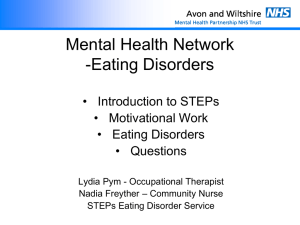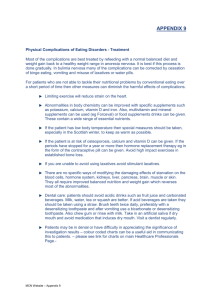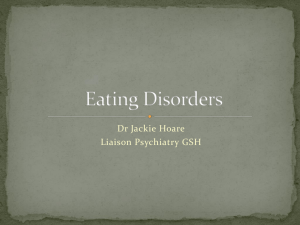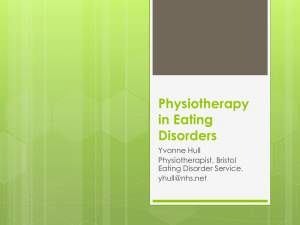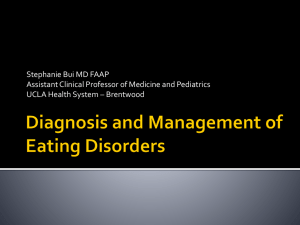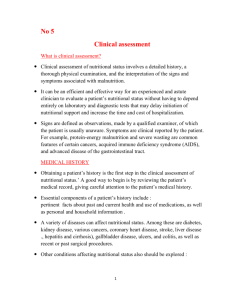DSM IV Diagnostic Criteria for Anorexia Nervosa
advertisement
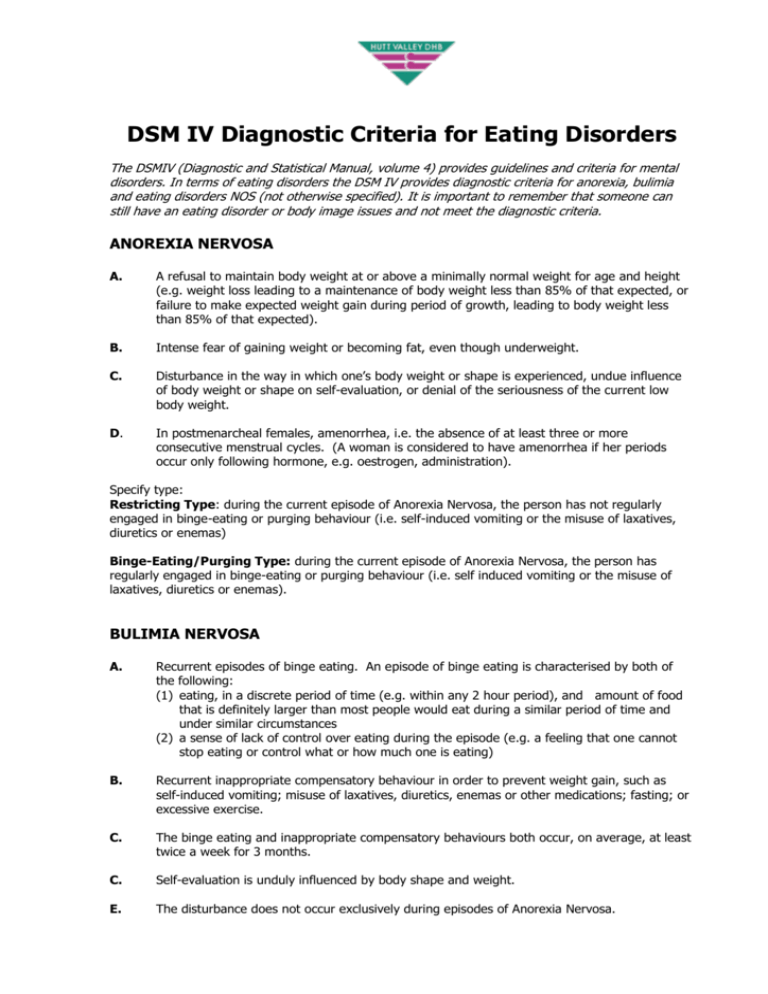
DSM IV Diagnostic Criteria for Eating Disorders The DSMIV (Diagnostic and Statistical Manual, volume 4) provides guidelines and criteria for mental disorders. In terms of eating disorders the DSM IV provides diagnostic criteria for anorexia, bulimia and eating disorders NOS (not otherwise specified). It is important to remember that someone can still have an eating disorder or body image issues and not meet the diagnostic criteria. ANOREXIA NERVOSA A. A refusal to maintain body weight at or above a minimally normal weight for age and height (e.g. weight loss leading to a maintenance of body weight less than 85% of that expected, or failure to make expected weight gain during period of growth, leading to body weight less than 85% of that expected). B. Intense fear of gaining weight or becoming fat, even though underweight. C. Disturbance in the way in which one’s body weight or shape is experienced, undue influence of body weight or shape on self-evaluation, or denial of the seriousness of the current low body weight. D. In postmenarcheal females, amenorrhea, i.e. the absence of at least three or more consecutive menstrual cycles. (A woman is considered to have amenorrhea if her periods occur only following hormone, e.g. oestrogen, administration). Specify type: Restricting Type: during the current episode of Anorexia Nervosa, the person has not regularly engaged in binge-eating or purging behaviour (i.e. self-induced vomiting or the misuse of laxatives, diuretics or enemas) Binge-Eating/Purging Type: during the current episode of Anorexia Nervosa, the person has regularly engaged in binge-eating or purging behaviour (i.e. self induced vomiting or the misuse of laxatives, diuretics or enemas). BULIMIA NERVOSA A. Recurrent episodes of binge eating. An episode of binge eating is characterised by both of the following: (1) eating, in a discrete period of time (e.g. within any 2 hour period), and amount of food that is definitely larger than most people would eat during a similar period of time and under similar circumstances (2) a sense of lack of control over eating during the episode (e.g. a feeling that one cannot stop eating or control what or how much one is eating) B. Recurrent inappropriate compensatory behaviour in order to prevent weight gain, such as self-induced vomiting; misuse of laxatives, diuretics, enemas or other medications; fasting; or excessive exercise. C. The binge eating and inappropriate compensatory behaviours both occur, on average, at least twice a week for 3 months. C. Self-evaluation is unduly influenced by body shape and weight. E. The disturbance does not occur exclusively during episodes of Anorexia Nervosa. Specify type: Purging Type: during the current episode of Bulimia Nervosa, the person has regularly engaged in self-induced vomiting or the misuse of laxatives, diuretics or enemas. Nonpurging Type: during the current episode of Bulimia Nervosa, the person has used other inappropriate compensatory behaviours, such as fasting or excessive exercise, but has not regularly engaged in self-induced vomiting or the misuse of laxatives, diuretics or enemas. EATING DISORDER NOT OTHERWISE SPECIFIED (EDNOS) The Eating Disorder Not Otherwise Specified category is for disorders of eating that do not meet the criteria for any specific Eating Disorder. Examples include: 1 For females, all the criteria for Anorexia Nervosa are met except that the individual has regular menses. 2 All the criteria for Anorexia Nervosa are met except that, despite significant weight loss, the individual’s current weight is in the normal range. 3 All the criteria for Bulimia Nervosa are met except that the binge eating and inappropriate compensatory mechanisms occur at a frequency of less than twice a week or for a duration of less than 3 months. 4 The regular use of inappropriate compensatory behaviour by an individual of normal body weight after eating small amounts of food (e.g. self-induced vomiting after the consumption of two biscuits. 5 Repeatedly chewing and spitting out, but not swallowing, large amounts of food. 6 Binge-eating disorder: recurrent episodes of binge eating in the absence of the regular use of inappropriate compensatory behaviours characteristic of Bulimia Nervosa. References American Psychiatric Association. (1994). Diagnostic and Statistical Manual of Mental Disorders (4th Ed.) United States of America: American Psychiatric Association. © Central Region Eating Disorder Services 2007


